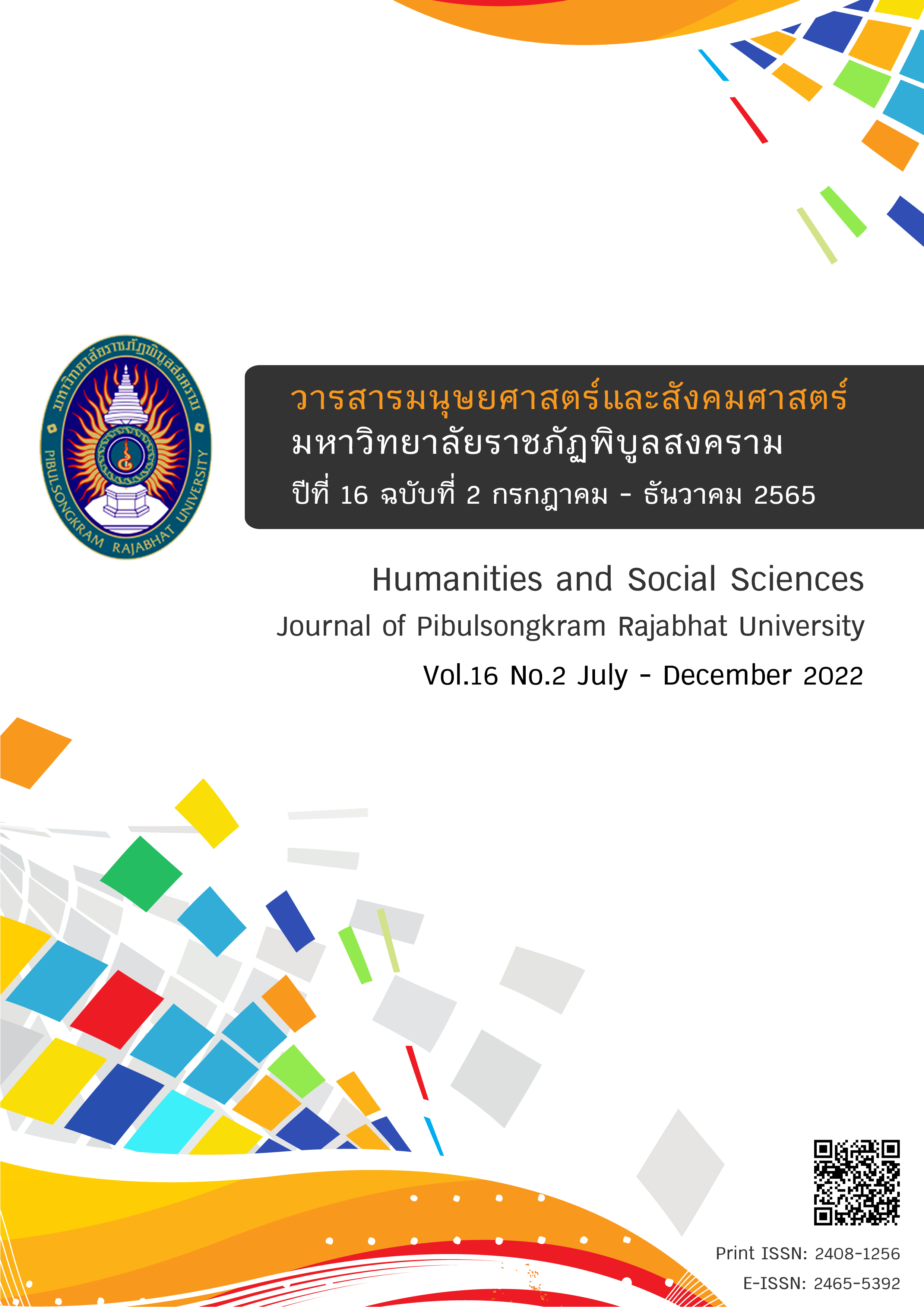A Structural Model of the Causal Relationship Between Organization Context and Professional Competency of Chef Affecting Organizational Performance of Food Business
DOI:
https://doi.org/10.14456/psruhss.2022.48Keywords:
Professional competencies, Organizational cultures, Corporate atmosphere, PerformanceAbstract
This research aims to 1) develop a structural model of causal relationships between organizational context and the professional competencies of the kitchen chief that affect the performance of the organization in the restaurant business organization 2) test the structural model of causal relationships with empirical data. The sample group was the head of the kitchen chef and was a member of the Chef Association of Thailand in Bangkok and metropolitan area, 556 people were obtained by using the Stratified Sampling The research tool were questionnaire, rating scale with a 5-level. Statistics that use to data analysis is structural equation model (SEM) analysis. The results of the research were. Structural models of causal relationships between organizational context and the professional competencies of the kitchen chief that affect the performance of the organization in the restaurant business organization is consistent with empirical data. The consistency index value were as follows: , p-value = 0.18, RMSEA = 0.014, RMR = .0034 NFI = 1, NNFI = 1, GFI = .97, AGFI = .97. All independent variables can explain the variance of the organization's performance as 89%. The organization culture directly affects the happy organization and professional competency, meanwhile indirectly affects the performance of the organization. While the corporate atmosphere has direct impact on happy organization and its performance. Finally, professional competencies has significantly direct impact on the performance of the organization at the .01 level of significance.
References
จารุวรรณ ประดา. (2545). ความสัมพันธ์ระหว่างปัจจัยส่วนบุคคล วัฒนธรรมองค์การลักษณะ สร้างสรรค์ ความพร้อมขององค์การกับความยึดมั่นผูกพันขององค์การ ตามการรับรู้ของ พยาบาลวิชาชีพ โรงพยาบาลจิตเวช. (วิทยานิพนธ์ปริญญามหาบัณฑิต). กรุงเทพฯ: จุฬาลงกรณ์มหาวิทยาลัย.
ไพฑูรย์ สินลารัตน์. ( 2558). ศาสตร์การคิด.พิมพ์ครั้งที่ 1. กรุงเทพฯ : สำนักพิมพ์มหาวิทยาลัยธุรกิจบัณฑิตย์.
ทิพวรรณ หล่อสุวรรณรัตน์. (2553). องค์การแห่งความรู้;จากแนวคิดสู่การปฏิบัติ. กรุงเทพฯ: แซทไฟร์ พริ้นติ้ง.
บุณฑริกา แจ้งเจริญกิจ. (2556) . บรรยากาศองค์การที่มีอิทธิพลต่อพฤติกรรมการเป็นสมาชิกที่ดีขององค์กรการของบุคลากรสำนักงานอธิการบดีมหมาวิทยาลัยมหิดล . มหาวิทยาลัยมหิดล/นครปฐม.
เบญจพร กลิ่นสีงาม. (2559). ปัจจัยที่มีอิทธิพลต่อพฤติกรรมการเป็นสมาชิกที่ดีขององค์การและประสิทธิภาพในการปฏิบัติงานของบุคลากร กรณีศึกษา : กรมวิชาการเกษตร กระทรวงเกษตรและสหกรณ์. วิทยานิพนธ์หลักสูตรวิทยาศาสตรมหาบัณฑิต สาขาวิชาการจัดการทรัพยากรมนุษย์ วิทยาลัยบัณฑิตศึกษาด้านการจัดการ มหาวิทยาลัยศรีปทุม.
มูลนิธิสถาบันวิจัยและพัฒนาผู้สูงอายุไทย. (2556). รายงานสถานการณ์ผู้สูงอายุไทย พ.ศ.2555.สนับสนุนโดย กองทุนผู้สูงอายุคณะกรรมการผู้สูงอายุแห่งชาติ. กรุงเทพฯ: ทีคิว พี.
รัตติกรณ์ จงวิศาล. (2554). มนุษยสัมพันธ์ : พฤติกรรมมนุษย์ในองค์การ. พิมพ์ครั้งที่ 3. กรุงเทพฯ : สำนักพิมพ์มหาวิทยาลัยเกษตรศาสตร์.
ลลิดา มาไพศาลทรัพย์. (2557). สรรสาระองค์กรแห่งความสุข. คณะสังคมศาสตร์และมนุษยศาสตร์มหาวิทยาลัยมหิดล. กรุงเทพฯ : พี.เอ. ลีฟวิ่ง.
วิรัช สงวนวงศ์วาน. (2551). การจัดการและพฤติกรรมองค์การ. กรุงเทพฯ: เพียร์สัน เอ็ดดุเคชั่น อินโดไชน่า.
สมยศ นาวีการ. (2554). ภาวะผู้นําเชิงกลยุทธ์. กรุงเทพฯ : อักษรไทย.
สมาคมเชฟประเทศไทย. (2561) รายงานสถิติการจ้างงานในตำแหน่งเชฟในกลุ่มธุรกิจและอุตสาหกรรมอาหารในปี พ.ศ. 2561. สืบค้นเมื่อวันที่ 20 มีนาคม 2563. จากเว็ปไซต์ https://www.thailandchef.in.th/.
สุวัฒน์ ศิรินิรันดร์ และภาวนา สายชู (2552). MBA HANDBOOK. พิมพ์ครั้งที่ 11. กรุงเทพฯ : ออฟเซท.
อนุสรณ์ แสนเคน. (2562). รูปแบบความสัมพันธ์เชิงสาเหตุของปัจจัยที่ส่งผลต่อสมรรถนะสถานศึกษา ในภาคตะวันออกเฉียงเหนือ สังกัดสำนักงานคณะกรรมการการศึกษาขั้นพื้นฐาน. วารสารบริหารการศึกษา มศว. 16(30),89-100.
อานันท์ เกียรติสารพิภพ. (2562). Academic Focus (ก.พ. 2562) Disruptive Technology การดำรงชีวิตจะเปลี่ยนไป. สำนักวิชาการ สำนักงานเลขาธิการสภาผู้แทนราษฎร.
Abdullah et.al, . (2011). The development of Human Resource Practitioner Competency Model Perceived by Malasian Human Resource Practitioners and Consultants: A Structural Equation Modeling (SEM) Approach. International Journal of Business and Management. 6(11), 240-255.
Dubois D. David, Rothwell J. William. (2004) .Competency – Based Human Resource Management. Davies – Black Publishing, California.Davies and Ellison(1997:39-40).
Gordon, J. R. (1998). Organizational Behavior: A Diagnostic Approach. (6th ed.). New York: Prentice –Hall.
Guilford, J.P. (1967). The Nature of Human Intelligence. McGraw-Hill, Book Company.
Hutton, J.G. (1999).The definition, dimension , and domain of public relations Public Relation Review,25 (2),pp. 199-214.
John Overby. (2012). A Second Order Confirmatory Factor Analysis Of A Leadership Competency Model: An Empirical Study Conducted In Thailand. The Journal of Applied Business Research.28(5),1073-1084.
Lockwood, N. R. (2003). Work life balance: Challenges and solutions, HRMagazine, Vol 48, Iss 6, p S1, Society for Human Resource Management, Alexandria.
Manion, Jo. (2003). “Joy at Work: Creating a Positive Work Place”. Journal of Nursing Administration, 33(12), 652 – 655.
McClelland, David C. (1973). “Testing for Competence rather than Intelligence.” American Psychologist. Retrieved December 11, 2005, from www.ei. Haygroup.com
Palan R. (2003). Competency Manafement : A Practitioner Guide. Rosetta Solutions,Inc. (Ebook Edition), from www.rosettasolution.com.
Warr, P. (2007). Work, happiness, and unhappiness. New Jersey: Lawrence Erlbaum Associates.
Downloads
Published
How to Cite
Issue
Section
License
Copyright (c) 2021 Humanities and Social Sciences Journal of Pibulsongkram Rajabhat University

This work is licensed under a Creative Commons Attribution-NonCommercial-NoDerivatives 4.0 International License.
Any articles or comments appearing in the Journal of Humanities and Social Sciences, Rajabhat Phibulsongkram University, are the intellectual property of the authors, and do not necessarily reflect the views of the editorial board. Published articles are copyrighted by the Journal of Humanities and Social Sciences, Rajabhat Phibulsongkram University.









